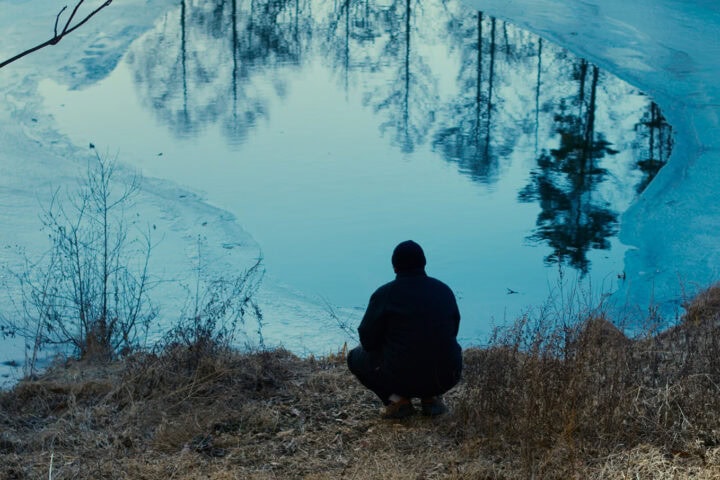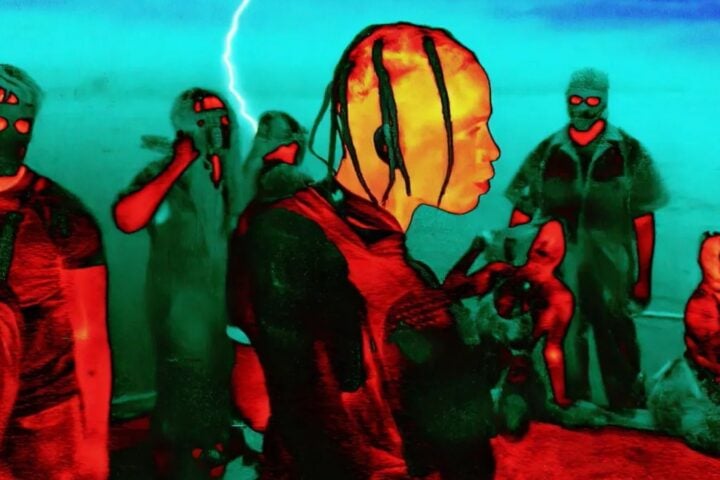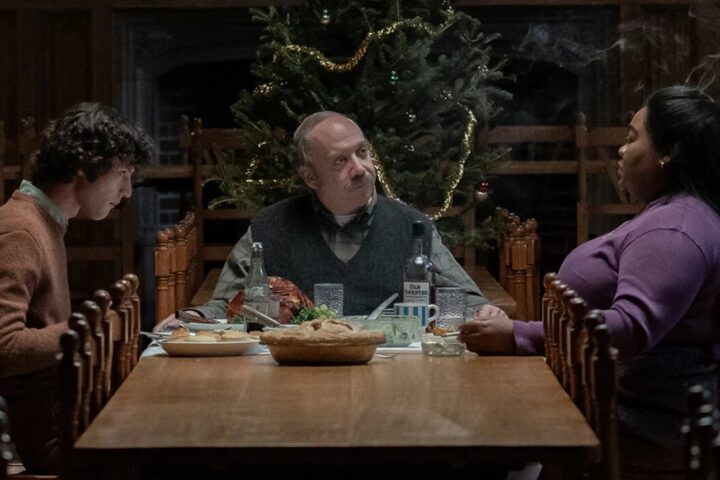Hamaguchi Ryûsuke’s Evil Does Not Exist is a turn away from the empathy of the filmmaker’s earlier work and toward an aesthetic that’s jagged and chilly. Watching the film brings to mind the evolution of the career of Paul Thomas Anderson, who went from crafting messy humanist spectacles to austere, immaculate chamber pieces that appear to exist in perpetual anxiety over being digested on conventional emotional terms. Evil Does Not Exist suggests a similar turn for Hamaguchi, and though this film finds him more than capable of playing the role of cryptic genius auteur, one may wonder what is lost in the trade.
Evil Does Not Exist’s first images embody the tension of the title, which seems to promise assurance with the meter of a warning. Tracking shots move through a forest from the vantage point of the ground, as if someone is on their back and floating while looking up at the sloping umbrellas formed by the branches of the trees. This sequence is beautiful and tranquil, the floating motif suggesting a vacating spirit’s last mournful look at the world.
The images alternate with a minimalist credits sequence and are heightened by Ishibashi Eiko’s haunting score, which suggests a blend of Philip Glass’s crystalline despair with the operatic undertow of Howard Shore’s work for David Cronenberg. The enveloping yet cold images put us on our guard, while the score prepares us to be moved. Every scene in the film is designed in such a way, pulling us simultaneously toward opposing emotional responses.
The forest is a pivotal part of Evil Does Not Exist’s chief setting, Mizubiki Village, a small and isolated countryside community that’s far enough from Tokyo to offer a relief from the clutter and freneticism of city life but close enough to be easily reachable by city folk. Precisely because it’s so beautiful, the community is destined to be gobbled up by developers as a vacation paradise for the wealthy, who can then price out the folks who were living there first and bothered to acclimate themselves to the culture of the countryside.
Hamaguchi’s elliptical narrative charts the beginning of this invasion. A company is looking to install a glamping site in the forest of the village, and assembles a town hall so as to make a pretense of giving a damn what the townspeople think. The locals inevitably have objections. For one, they’d prefer that the company building the glamping site would take care not to pollute their fresh, natural drinking water with the sewage of strangers looking to unwind.
The early vignettes portraying life in Mizubiki Village and its surrounding forest, and the long sequence dramatizing the town hall that portends an encroaching capitalist invasion, compose more than half of the film. Running 106 minutes, Evil Does Not Exist is less open than Hamaguchi’s leisurely, airy Happy Hour, which runs over five hours, and Drive My Car, which is three hours. Even shorter Hamaguchi films like Passion and Wheel of Fortune and Fantasy leave room for the viewer to roam among characters and dramatic possibilities. By stark contrast, Evil Does Not Exist is curt and concentrated, less interested in its characters than in ruminating in a roiling atmosphere, eventually offering proof of its theme.
Throughout, Hamaguchi spends considerable time watching manly, handy Takumi (Omika Hitoshi) chop wood for his cabin, and gather water from a creek for himself and the noodle shop in town. These scenes are hypnotic, especially the wood-chopping, which, with its sense of inchoate violence, prepares the viewer for something that isn’t apparent until the film’s ending. But the tension resides in the unusual emphases: What does several minutes of Takumi chopping wood tell us that 30 seconds wouldn’t? It’s a difference of biorhythm. The longer we see, the more we inhabit this action of which a tourist is ignorant. This is the work of earning the idyll, the work that the tourist trade allows people to run roughshod over.
The pastoral scenes of Takumi navigating the woods, chopping logs, and teaching his eight-year-old daughter, Hana (Nishikawa Ryo), the ways of the land—from the tracks of the deer to the types of trees that grow nearby—are emotionally involving. Yet Hamaguchi routinely alienates his audience. Evil Does Not Exist’s score sweeps us up yet often drops off the soundtrack abruptly, seemingly mid-note, before we’ve had the opportunity to “land.”
Viewers may feel as if they’ve been left hanging, a sensation that’s also evoked by tracking shots with seemingly unmotivated perspectives. When Takumi picks his daughter up from school, the camera seems to affix itself to the back of his car, as if we’re hopping on the bumper and riding along. It’s an accomplished shot that consciously prompts you to ask why? As hypnotic as the film is, it’s distant, with a score to settle. Hamaguchi keeps you off guard, feeling jittery.
The town hall sequence, then, is a relief for playing to Hamaguchi’s traditional strengths, namely an ability to vividly establish many characters in a matter of seconds, fashioning a rich infrastructure of motivations and emotions. It also has one robust surprise: The representatives hired to sell the glamping project to the locals, Takahashi (Kosaka Ryuji) and Mayuzumi (Shibutani Ayaka), are sympathetically drawn as cogs in a machine, saddled with an assignment that they don’t understand. Hamaguchi follows these characters back on their own turf in Tokyo, where they try to talk their superiors into honoring the concerns of the locals.
Takahashi particularly seems to be in the grips of crisis, a kind of soul rot that’s played somewhat comically, briefly leavening Evil Does Not Exist’s tortured atmosphere. When Takahashi falls into a friendly dynamic with Takumi back in the woods, it feels as if an odd-couple situation is being set up, one which the Hamaguchi of Happy Hour or Drive My Car would be more than happy to exploit and probably transcend.
But this Hamaguchi fashions a narrative trap door. An odd-couple situation, even one as well performed as this one, is comfortable shtick—as is the melodrama of a missing person that unfolds near the film’s conclusion. Hamaguchi introduces these threads for the purpose of brutally discarding them. Violence occurs so randomly that one isn’t sure what’s being shown at first, and then Evil Does Not Exist ends in media res, with every plotline left hanging.
The town hall sequence sets up a variety of characters who barely figure into Hamaguchi’s grand design. The final scene, possibly a death rattle, certainly a gasp of despair, and captured in a tracking shot that mirrors the film’s first image, is designed to provoke anger, which is Hamaguchi’s subject here. The driving motivation is bitter, impotent, unrelieved fury, which is prompted in people of little means when chased off their land by an elite that seems determined to render everyone else’s land unlivable, everyone else’s rent and mortgage unpayable.
Had the townsfolk been pitted against the glamping developers, or Takumi and Takahashi been allowed to bond and teach one another life lessons, Hamaguchi might have let us off the political hook, comforting us with fantasy. Curtailing his narratives, seizing up his action, which he foreshadows with the clipped-off score and strange tracking shots, Hamaguchi forces us to reckon with the industrialization of nature—and stew in it. Evil Does Not Exist is a politically engaged act of coitus interruptus, then, though you may not be convinced that Hamaguchi’s new interest in theme over character is a wonderful development in the long run. Preachers are a dime a dozen, while true humanists are as endangered as the woods of Mizubiki Village.
Since 2001, we've brought you uncompromising, candid takes on the world of film, music, television, video games, theater, and more. Independently owned and operated publications like Slant have been hit hard in recent years, but we’re committed to keeping our content free and accessible—meaning no paywalls or fees.
If you like what we do, please consider subscribing to our Patreon or making a donation.





